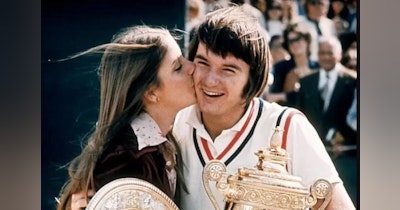From an inauspicious first match in front of a few hundred people, Chrissie and Martina’s rivalry evolves into a captivating and seesawing set piece that unfolds on the world’s biggest sporting stages for almost two decades. It’s unquestionably the greatest and longest-running individual rivalry in sports history. In a nutshell, the anatomy of this rivalry is having two complex, flawed and wildly different protagonists, who clash so often and for so long, that their on-court battles become a prism of their personal and professional evolution. Chrissie and Martina do more than challenge each other. They reveal each other.
For sixteen years they drive each other through storybook realms of pain and glory, epic duels and high-stakes drama. They define an era. Chrissie and Martina come of age just as women’s tennis is rising from backwater to big time.
Their rivalry transforms tennis from an enjoyable pastime into the most lucrative of sports. The tennis they play isn’t the polite pitty-pat of the country club. These are tough, grimacing, cramp inducing, pressure-filled, heavy-weight contests. Their lockstep careers play out against the backdrop of the women’s movement, fight for Title IX and the fall of the iron curtain. The performance standards and personal convictions that these rivals demonstrate will influence female athletes for decades to come.
Chrissie and Martina share the ultimate goal of becoming the best tennis player in history. It’s a self-defining push to see where their personal limits might lie. They are among the new breed of fiercely independent, unapologetically ambitious women whose partners are often a peripheral presence in their public lives. And when love lives clash with careers, it’s tennis that almost always wins.
Chrissie and Martina are two people who fervently want the same thing, find the other blocking the way, and ultimately forgive each other for it. They are bound together by their superiority. The only opponents they fear are each other. They come to realize that they are the only two people who truly understand what the other is going through. And it explains how with the match over, they can return to the locker room with the winner ready to console the heartbroken loser.
However, like any long-term relationship, this one also has its low points. When Chrissie begins to realize Martina’s true potential, she abandons her as a doubles partner. Under the tutelage of her partner, professional baketballer, Nancy Lieberman, Martina is encouraged to adopt a much more aggressive persona. Indeed, she’s instructed to “hate” Chrissie and their friendship suffers the inevitable consequences.
This photo from Super Saturday 1984 (still the best day of tennis I've ever seen), captures Chrissie's despondency after that brilliant final.
The rivals are a study in contrasts, a collision of styles, politics and looks. Fans feel so attached to a particular player, they declare themselves “Chrissie fans” or “Martina fans”. But pat portrayals like, “Chrissie the girl next door vs. Martina the lesbian outsider”, are too simplistic. The truth, as usual, is more complicated.
Chrissie grows up a shy girl in a conservative Catholic family. She’s coached by her father from an early age and excels. Success and accolades give her social confidence. In adolescence, she elopes with tennis bad boy and fellow world number one, Jimmy Connors. They get engaged and have an on-again, off-again relationship for several years. Chrissie goes on to date Hollywood actors like Burt Reynolds, rock stars, TV personalities and even a President’s son. In 1978, she marries top ten player and English heart-throb, John Lloyd.
Chrissie becomes a master of mind games and psyching out opponents. She has the best dirty jokes, enjoys a drink and even smokes dope. The inconsistencies between her clean-cut “America’s Sweetheart” public image and her naturally darker impulses, fester discomfort and inner turmoil throughout her entire career. Decades before celebrity athletes like Maria Sharapova, People magazine covered Chrissie’s romances. She sits for an Andy Warhol portrait and is the first female athlete to host Saturday Night Live. Chrissie foreshadows the “women who want it all” ethos.
While Chrissie can do no wrong in the public’s eye, Martina endures a career-long fight for acceptance. Martina’s relationships with Lieberman and feminist author, Rita Mae Brown, are scrutinized by the press. She’s marginalized as the lesbian partner of a divorced Texas beauty queen and mother of two, Judy Nelson. One of her coaches is the six-foot-two transsexual, Renee Richards. As Martina begins to reverse her lopsided match history against Chrissie, she’s increasingly cast as a sneering and villainous colossus. The truth is that she’s a sensitive and generous young woman who tears up watching TV commercials.
Martina revolutionizes the way in which women athletes train and compete. She presages what life will be like for people who dare to be openly gay. She defects to the USA from Czechoslovakia in 1975 and rises to prominence as the Cold War continues. But the price for freedom is high. At only eighteen, Martina leaves behind her parents, younger sister and beloved grandmother. She’s declared a non-person and threatened with jail if she returns.
In her new American homeland, Martina indulges in junk food binges and excessive shopping sprees for clothing, jewelry and cars. But at age twenty-five, she hunkers down, determined to discover her potential. She reinvents her body and game. Combine this with her refusal to tolerate Communist oppression and her unwavering insistence on always being treated with basic decency, and there’s a similarity to the young Cassius Clay transforming into Muhammad Ali.
Martina never stops doing or saying what she believes in, even if it’s at the expense of profitable commercial endorsements. People make wisecracks about her sexuality, her physicality and her entourage of coaches and advisors. Grueling training schedules and specialist support teams subsequently became mandatory for professional players.
While people who watched tennis in the 70’s and 80’s and current fans should enjoy the podcast, the show’s globally recognized characters, operatic qualities and universal themes should appeal to a broad audience of all ages.
A large portion of the above text is taken from Johnette Howard's absolutely superb book, "The Rivals". I have a read a lot of sports books over the years and this is without question one of the best!






















